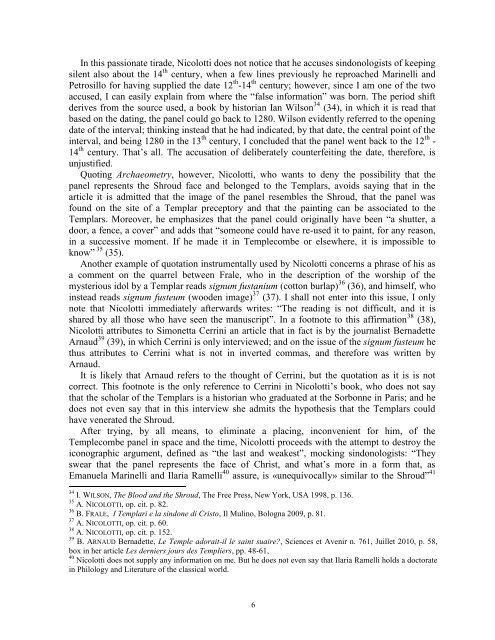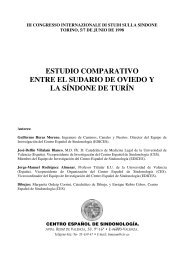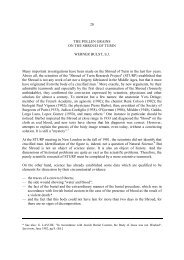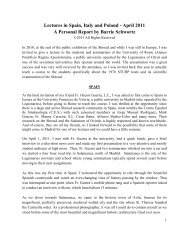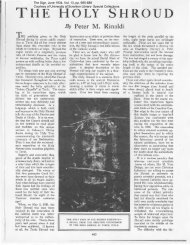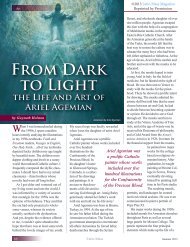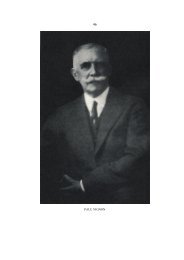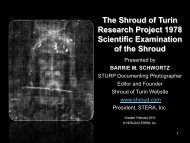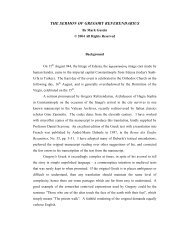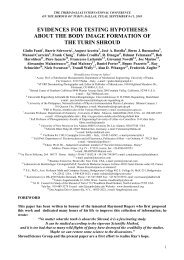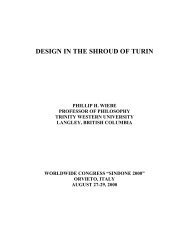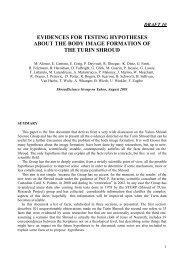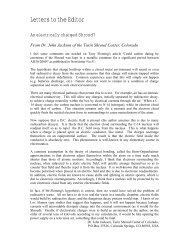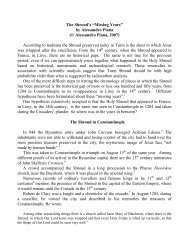BSTS Newsletter No. 74 - Part 8 - The Shroud of Turin Website
BSTS Newsletter No. 74 - Part 8 - The Shroud of Turin Website
BSTS Newsletter No. 74 - Part 8 - The Shroud of Turin Website
Create successful ePaper yourself
Turn your PDF publications into a flip-book with our unique Google optimized e-Paper software.
In this passionate tirade, Nicolotti does not notice that he accuses sindonologists <strong>of</strong> keepingsilent also about the 14 th century, when a few lines previously he reproached Marinelli andPetrosillo for having supplied the date 12 th -14 th century; however, since I am one <strong>of</strong> the twoaccused, I can easily explain from where the “false information” was born. <strong>The</strong> period shiftderives from the source used, a book by historian Ian Wilson 34 (34), in which it is read thatbased on the dating, the panel could go back to 1280. Wilson evidently referred to the openingdate <strong>of</strong> the interval; thinking instead that he had indicated, by that date, the central point <strong>of</strong> theinterval, and being 1280 in the 13 th century, I concluded that the panel went back to the 12 th -14 th century. That’s all. <strong>The</strong> accusation <strong>of</strong> deliberately counterfeiting the date, therefore, isunjustified.Quoting Archaeometry, however, Nicolotti, who wants to deny the possibility that thepanel represents the <strong>Shroud</strong> face and belonged to the Templars, avoids saying that in thearticle it is admitted that the image <strong>of</strong> the panel resembles the <strong>Shroud</strong>, that the panel wasfound on the site <strong>of</strong> a Templar preceptory and that the painting can be associated to theTemplars. Moreover, he emphasizes that the panel could originally have been “a shutter, adoor, a fence, a cover” and adds that “someone could have re-used it to paint, for any reason,in a successive moment. If he made it in Templecombe or elsewhere, it is impossible toknow” 35 (35).Another example <strong>of</strong> quotation instrumentally used by Nicolotti concerns a phrase <strong>of</strong> his asa comment on the quarrel between Frale, who in the description <strong>of</strong> the worship <strong>of</strong> themysterious idol by a Templar reads signum fustanium (cotton burlap) 36 (36), and himself, whoinstead reads signum fusteum (wooden image) 37 (37). I shall not enter into this issue, I onlynote that Nicolotti immediately afterwards writes: “<strong>The</strong> reading is not difficult, and it isshared by all those who have seen the manuscript”. In a footnote to this affirmation 38 (38),Nicolotti attributes to Simonetta Cerrini an article that in fact is by the journalist BernadetteArnaud 39 (39), in which Cerrini is only interviewed; and on the issue <strong>of</strong> the signum fusteum hethus attributes to Cerrini what is not in inverted commas, and therefore was written byArnaud.It is likely that Arnaud refers to the thought <strong>of</strong> Cerrini, but the quotation as it is is notcorrect. This footnote is the only reference to Cerrini in Nicolotti’s book, who does not saythat the scholar <strong>of</strong> the Templars is a historian who graduated at the Sorbonne in Paris; and hedoes not even say that in this interview she admits the hypothesis that the Templars couldhave venerated the <strong>Shroud</strong>.After trying, by all means, to eliminate a placing, inconvenient for him, <strong>of</strong> theTemplecombe panel in space and the time, Nicolotti proceeds with the attempt to destroy theiconographic argument, defined as “the last and weakest”, mocking sindonologists: “<strong>The</strong>yswear that the panel represents the face <strong>of</strong> Christ, and what’s more in a form that, asEmanuela Marinelli and Ilaria Ramelli 40 assure, is «unequivocally» similar to the <strong>Shroud</strong>” 4134 I. WILSON, <strong>The</strong> Blood and the <strong>Shroud</strong>, <strong>The</strong> Free Press, New York, USA 1998, p. 136.35 A. NICOLOTTI, op. cit. p. 82.36 B. FRALE, I Templari e la sindone di Cristo, Il Mulino, Bologna 2009, p. 81.37 A. NICOLOTTI, op. cit. p. 60.38 A. NICOLOTTI, op. cit. p. 152.39 B. ARNAUD Bernadette, Le Temple adorait-il le saint suaire?, Sciences et Avenir n. 761, Juillet 2010, p. 58,box in her article Les derniers jours des Templiers, pp. 48-61,40 Nicolotti does not supply any information on me. But he does not even say that Ilaria Ramelli holds a doctoratein Philology and Literature <strong>of</strong> the classical world.6


